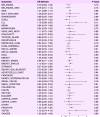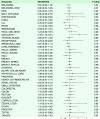Causal relationship between anti-inflammatory drugs and cancer: a pan-cancer study with Mendelian randomization
- PMID: 38854429
- PMCID: PMC11156997
- DOI: 10.3389/fgene.2024.1392745
Causal relationship between anti-inflammatory drugs and cancer: a pan-cancer study with Mendelian randomization
Abstract
Background: Numerous epidemiological studies have elucidated the intricate connection between inflammation and cancer, highlighting how sustained inflammatory responses can fuel carcinogenesis by fostering proliferation, angiogenesis, and metastasis, while dampening immune responses and sensitivity to chemotherapy. Previous clinical investigations have underscored the potential of anti-inflammatory medications in either preventing or mitigating tumor formation. Here, the causal relationship between anti-inflammatory drugs and cancer was further explored through Mendelian randomization studies.
Methods: Employing Mendelian randomization, we scrutinized the causal links between three anti-inflammatory drugs-NSAIDs, Aspirin, and Anilide-and 37 types of cancer. We primarily utilized inverse variance weighting (IVW) as the primary analytical approach to delineate the causal association between these drugs and cancer types. Concurrently, sensitivity analyses were conducted to ascertain the absence of horizontal pleiotropy and heterogeneity.
Results: Our investigation revealed a discernible causal relationship between certain anti-inflammatory drugs and a subset of cancers, albeit without a pervasive impact across all cancer types. Specifically, NSAIDs exhibited a risk-reducing effect on non-small cell lung cancer (OR: 0.76, 95% CI: 0.59-0.97, p-value: 0.03) and gastric cancer (OR: 0.57, 95% CI: 0.34-0.98, p-value: 0.04). Conversely, aspirin was associated with an increased risk of oral malignant tumors (OR: 2.18, 95% CI: 1.13-4.21, p-value: 0.02). Notably, no statistically significant findings were observed for anilide drugs (p < 0.05).
Conclusion: We identified several cancers with potential causal links to NSAIDs, including non-small cell lung cancer and gastric cancer. Despite our extensive analysis, we did not identify a substantial causal relationship between the use of anti-inflammatory drugs and the development of various cancers.
Keywords: Mendelian randomization analysis; NSAIDs; anilide; anti-inflammatory medications; aspirin; pancancer.
Copyright © 2024 Gao, Wei, Ma, Wang, Wang and Niu.
Conflict of interest statement
The authors declare that the research was conducted in the absence of any commercial or financial relationships that could be construed as a potential conflict of interest.
Figures





Similar articles
-
Causal Effects and Immune Cell Mediators of Prescription Analgesic Use and Risk of Liver Cancer and Precancerosis in European Population: A Mendelian Randomization Study.Biomedicines. 2024 Jul 11;12(7):1537. doi: 10.3390/biomedicines12071537. Biomedicines. 2024. PMID: 39062110 Free PMC article.
-
Association between 23 drugs and inflammatory bowel disease: a two-sample Mendelian randomization study.Front Med (Lausanne). 2024 May 21;11:1371362. doi: 10.3389/fmed.2024.1371362. eCollection 2024. Front Med (Lausanne). 2024. PMID: 38835788 Free PMC article.
-
Causal relationship between thyroid dysfunction and gastric cancer: a two-sample Mendelian randomization study.Front Endocrinol (Lausanne). 2024 Apr 26;15:1335149. doi: 10.3389/fendo.2024.1335149. eCollection 2024. Front Endocrinol (Lausanne). 2024. PMID: 38737547 Free PMC article.
-
Association between testosterone and cancers risk in women: a two-sample Mendelian randomization study.Discov Oncol. 2023 Nov 4;14(1):198. doi: 10.1007/s12672-023-00811-2. Discov Oncol. 2023. PMID: 37924384 Free PMC article.
-
Epidemiology of non-steroidal anti-inflammatory drugs and cancer.Prog Exp Tumor Res. 2003;37:1-24. doi: 10.1159/000071364. Prog Exp Tumor Res. 2003. PMID: 12795046 Review.
Cited by
-
Causal Effects and Immune Cell Mediators of Prescription Analgesic Use and Risk of Liver Cancer and Precancerosis in European Population: A Mendelian Randomization Study.Biomedicines. 2024 Jul 11;12(7):1537. doi: 10.3390/biomedicines12071537. Biomedicines. 2024. PMID: 39062110 Free PMC article.
-
Genetically proxied risk and protective factors for pancreatic cancer: a systematic review and meta-analysis of Mendelian randomization studies.J Gastrointest Oncol. 2025 Jun 30;16(3):1233-1247. doi: 10.21037/jgo-2025-305. Epub 2025 Jun 27. J Gastrointest Oncol. 2025. PMID: 40672103 Free PMC article.
References
LinkOut - more resources
Full Text Sources

